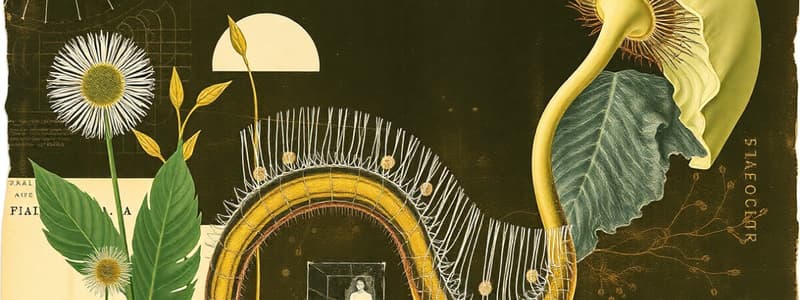Podcast
Questions and Answers
What does the term 'pollen grain' refer to?
What does the term 'pollen grain' refer to?
- A structure that develops into a fruit
- A microscopic structure that contains the male gametophyte (correct)
- A part of the female gametophyte
- A type of cell that forms within the ovary
Double fertilization in angiosperms involves the fusion of two sperm cells with two different parts of the female gametophyte: one sperm with the egg cell and the other sperm with the central cell.
Double fertilization in angiosperms involves the fusion of two sperm cells with two different parts of the female gametophyte: one sperm with the egg cell and the other sperm with the central cell.
True (A)
What is the role of the endosperm in a seed?
What is the role of the endosperm in a seed?
The endosperm provides nourishment to the developing embryo.
Which of these is NOT a characteristic of angiosperm gametophytes?
Which of these is NOT a characteristic of angiosperm gametophytes?
What is the primary function of the tube cell in a pollen grain?
What is the primary function of the tube cell in a pollen grain?
The process of pollination is necessary for the development of angiosperm fruits.
The process of pollination is necessary for the development of angiosperm fruits.
What is the difference between the generative cell and the tube cell in a pollen grain?
What is the difference between the generative cell and the tube cell in a pollen grain?
The union of the two sperm cells with different tissue of the ovule where the egg has been fertilized is called ______ fertilization.
The union of the two sperm cells with different tissue of the ovule where the egg has been fertilized is called ______ fertilization.
Flashcards
Double Fertilization
Double Fertilization
The process by which one sperm fertilizes the egg to form a zygote and the other sperm fuses with the polar nuclei to develop into a triploid endosperm.
Megasporocyte
Megasporocyte
A specialized cell within the ovule that undergoes meiosis to produce four haploid megaspores, one of which will develop into the female gametophyte.
Embryo Sac
Embryo Sac
The structure that develops from the megaspore and contains the egg and other female gametes within the ovule.
Integument
Integument
Signup and view all the flashcards
Micropyle
Micropyle
Signup and view all the flashcards
Pollination
Pollination
Signup and view all the flashcards
Pollen Tube
Pollen Tube
Signup and view all the flashcards
Generative Cell
Generative Cell
Signup and view all the flashcards
Tube Cell
Tube Cell
Signup and view all the flashcards
Microsporocytes
Microsporocytes
Signup and view all the flashcards
Microspore
Microspore
Signup and view all the flashcards
Male Gametophyte
Male Gametophyte
Signup and view all the flashcards
Endosperm
Endosperm
Signup and view all the flashcards
Zygote
Zygote
Signup and view all the flashcards
Seed Germination
Seed Germination
Signup and view all the flashcards
Pistil
Pistil
Signup and view all the flashcards
Ovary
Ovary
Signup and view all the flashcards
Style
Style
Signup and view all the flashcards
Stigma
Stigma
Signup and view all the flashcards
Stamen
Stamen
Signup and view all the flashcards
Anther
Anther
Signup and view all the flashcards
Filament
Filament
Signup and view all the flashcards
Microsporangium
Microsporangium
Signup and view all the flashcards
Microsporocytes
Microsporocytes
Signup and view all the flashcards
Pollen Grain
Pollen Grain
Signup and view all the flashcards
Spore Wall
Spore Wall
Signup and view all the flashcards
Seed Germination
Seed Germination
Signup and view all the flashcards
Endosperm
Endosperm
Signup and view all the flashcards
Cotyledons
Cotyledons
Signup and view all the flashcards
Seed Coat
Seed Coat
Signup and view all the flashcards
Fruit
Fruit
Signup and view all the flashcards
Pericarp
Pericarp
Signup and view all the flashcards
Study Notes
Angiosperm Life Cycle Overview
- Angiosperms have a life cycle focusing on gametophyte development, sperm delivery (pollen tubes), and double fertilization.
- Gametophytes in angiosperms are small, dependent on the sporophyte for nutrients.
- Female gametophytes develop within ovules deep within the ovary.
- Male gametophytes form within pollen grains (anthers).
Female Gametophyte Development (Embryo Sacs)
- Ovules develop within the ovary.
- Megasporangium within ovule produces megaspores via meiosis.
- Only one megaspore survives and divides three times without cytokinesis, resulting in a multinucleate embryo sac with eight nuclei.
- The embryo sac contains an egg cell, two synergids, three antipodal cells, and two polar nuclei.
Male Gametophyte Development (Pollen Grains)
- Microsporangia (pollen sacs) form within anthers.
- Microsporocytes undergo meiosis to form microspores.
- Each microspore develops into a pollen grain with two cells: tube cell and generative cell.
Sperm Delivery by Pollen Tubes
- Pollen grain germinates and forms a pollen tube that grows through the style.
- The generative cell divides to form two sperm cells.
- The tube nucleus leads the way, following chemical attractants to the embryo sac.
- Sperm are released in vicinity of the embryo sac.
Double Fertilization
- One sperm fertilizes the egg, forming a diploid zygote.
- The other sperm fertilizes the two polar nuclei, forming a triploid endosperm.
- Double fertilization ensures that resources are allocated only to fertilized ovules.
Seed Development
- The ovule develops into a seed.
- The ovary develops into a fruit, aiding in seed dispersal.
- Seeds store nutrients (starch, proteins, oils) for the developing embryo, and in some cases cotyledons (seed leaves) take over this role.
- The seed embryo eventually develops into a new sporophyte when the seed germinates.
Studying That Suits You
Use AI to generate personalized quizzes and flashcards to suit your learning preferences.




